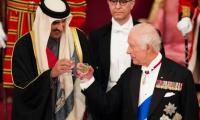On June 3, 1947, the British Government announced its plan to divide British Colonised India and the subsequent transfer of power to the new nations, Pakistan and India, leading to their independence. At the Division Council, chaired by Lord Mountbatten, the last Viceroy of India and attended by the leaders of the Muslim League and Indian National Congress, it was agreed that the British Indian Army consisting of 11,800 officers and 500,000 enlisted personnel was to be divided with a ratio of 64 per cent for India and 36 per cent for Pakistan. Pakistan was forced to accept a smaller share of the armed forces as most of the military assets, such as weapons depots, military bases, etc., were already located inside India, while those in Pakistan were few and too obsolete. Pakistan was also dangerously low on ammunition reserves (only a week). India and Pakistan had operational control over their armed forces by August 15, 1947.
Pakistan Army
The division of the British Indian Army took effect on June 30, 1947. General Frank Messervy was appointed as the first Commander in Chief (C-in-C) of the new Pakistan Army. He was succeeded by General Douglas Gracey, (February 1948 -January 1951). The first Muslim C-in-C, General Ayub Khan took over on January 16, 1951. To date, there have been sixteen Chiefs of the Pakistan Army.
The Pakistani Armed Forces initially numbered approximately 150,000 men, who were scattered all over India at different bases and needed to be transferred to Pakistan. In total, around 7 million Muslims migrated to Pakistan and 5 million Sikhs and Hindus to India with over a million people dying in the process, this transition not only delayed the move of the Pakistani designated troops to Pakistan but also extracted them from their existing jobs and in safety.
Out of the estimated requirement of 4,000 officers for the Pakistani Armed Forces, it only had 2,300. British officers were requisitioned to fill the gap, that is how nearly 500 volunteered along with many Polish and Hungarian officers. Pakistan received six armoured, eight artillery and eight infantry regiments while India got forty armoured, forty artillery and twenty-one infantry regiments.
By October 1947, Pakistan had raised four divisions in West Pakistan and one division in East Pakistan with an overall strength of ten infantry brigades and one armoured brigade with only thirteen tanks.
Bahawalpur was the only fully functioning state that Pakistan inherited; the state was equipped with its military and munitions. The Nawab of Bahawalpur also gave 70 million rupees to the Pakistani government for the salaries of Pakistani government sectors.
Indo-Pakistan War 1947
The first Indo-Pakistan War was fought from 1947 to 1948 in the Kashmir area. In an effort to liberate the maximum area of Jammu and Kashmir, the Pakistanis launched its tribal lashkars (militias) from NWFP (Now KP) to capture Kashmir and preempt the possibility of its ruler joining India. The inconclusive result of the war still affects the geopolitics of both countries. Hari Singh, the Maharaja of Jammu and Kashmir, faced an uprising by the Muslim subjects in Poonch and lost control of the western districts of his kingdom. On October 22, 1947, Pakistan’s tribal militants crossed the border of the state. The locals, tribal militias and irregular Pakistani forces moved to take the capital city of Srinagar but upon reaching Baramula, they took to plunder and delayed the operations. While the troops were about to take Srinagar and its airfield, Maharaja Hari Singh made a plea to India for assistance. He signed an Instrument of Accession to India on October 26, 1947 which was followed by airlifting of troops to Srinagar. A formal ceasefire was declared effective on January 1, 1949.
Indo-Pakistan War 1965
Prior to the start of the Indo-Pakistan War in September 1965, there was a skirmish in the Rann of Kutch in the Sind Sector, where the Indians intruded into the southern territories and challenged the Pakistani armed forces. Reinforcements were sent to the area that was hitherto being looked after by the border Rangers. The lost areas were won back and an uncertain and uneasy peace prevailed till a major clash took place in Kashmir Sector, and Pakistani forces took over first Chambb, then Jaurian and were knocking at the gates of Akhnur when the Indians attacked at Lahore and Sialkot, on September 6, 1965. The War lasted till 23rd September 1965, when the United Nations called for a cease-fire.
Indo-Pakistan War 1971
The third war with India was a result of Indian interference in the former East Pakistan province (now Bangladesh), which picked up impetus around November 1971, transiting into West Pakistan on December 6, 1971. This was the finale of the conspiracy crosshatched by India. Field Marshal Maneckshaw, in his recollections, highlighted his interview with BBC, where he revealed that it took him one year’s preparation for executing this plan. The Indians enjoyed indigenous support from the dissident Bengalis, the “Mukti Bahini”. The wrought was further aggravated by massive political mismanagement of the Pakistan leadership, who denied Shaikh Mujeeb Ur Rehman his democratic right to be the Prime Minister of Pakistan, after polls of 1970. General Yahya played to the tunes of Zulfiqar Ali Bhutto, who wanted to be the Prime Minister at any cost. He caused a delay of seven to ten days when he was sent as Foreign Minister by the President of Pakistan to the United Nations, to have the Polish Resolution implemented post haste. The Resolution was tabled by Poland at the beginning of December 1971, proposing a cessation of hostilities between India and Pakistan and calling for a ceasefire. Mr Bhutto feigned illness by design and slept, while precious time was wasted. He only attended the UN session after the Pakistani troops had surrendered on December 16, 1971. Had he attended the UN Session and accepted the ceasefire, the surrender of the Eastern Command would have never occurred.
UN Peace-Keeping
* Pakistan Army has been one of the major contributors of troops for the United Nations for peace-keeping and disaster management. Since 1960, Pakistan has sent more than 160,000 troops to 42 missions.
* They have envious figures of 138 martyrs, including 22 officers who lost their lives to save humanity. It is about 10 per cent of total causalities suffered by the UN peacekeeping missions since inception.
War on Terror
The War on Terror has been going on for the past two decades and this war has engaged all the defence services to eliminate the terrorists and their writ in the tribal areas of FATA. In 2011, 144 operations were carried out, resulting in the execution of 1,016 terrorists. In 2012, the Pakistan military brought peace to North Waziristan. In 2013, Karachi and Balochistan got rid of terrorists due to Pakistan Ranger’s operations. Operation Zarb-e-Azb focused on North Waziristan, killing 2,100 terrorists in the area till December 28, 2014. The Khyber-I operation in the Khyber Agency of FATA was against the TTP and its partner Lashkar-e-Islam. The Khyber-II operation was initiated in March 2015, with the intent to clear Tirah valley, which had transformed into a safe haven for TTP, Lashkar-e-Islam, and Jamaatul Ahrar. In 2015, the National Action Plan (NAP) took the task of bringing peace back to Karachi. In 2016, Balochistan was in focus. Pakistani law enforcement acted against Lashkar-e-Jhangvi (LeJ) and TTP-led Baloch extremist groups. In February 2017, Operation Raddul Fasaad (Counter Turmoil/Mayhem) eliminated the remaining terrorist elements from Lahore, Sehwan Sharif, Khyber Pakhtunkhwa and the erstwhile FATA. Operation Khyber-IV, mid-July 2017, helped in clearing Khyber Agency’s Rajgal Valley and Shawal Valley. Operation Raddul Fasaad brought a 59 per cent decline in terrorist activities in the country till 2018.
Pakistan Navy (PN)
The Pakistan Navy (PN) is the Naval Arm of the Pakistan Armed Forces. It came into existence with the remanent and the junk of the Royal Indian Navy equipment on August 14, 1947.
The Pakistan Navy has been in conflict with India on two occasions on its sea borders and has been repeatedly deployed in the Indian Ocean to act as a military advisor to the Gulf Arab states and other friendly nations during the events of multinational conflict as part of its commitment to the United Nations. Since its commencement on August 14, 1947, the defensive role of the Navy has expanded from securing the sealines and becoming the custodian of Pakistan’s second-strike capability with an ability to launch an underwater missile system to target enemy positions. Despite being a new service and having almost nothing on its inventory in men or material, the PN has a rich and star-chequered history as will glean into their past.
Rann of Kutch Skirmishes April 1965
In March 1965, the Indians carried out a joint exercise, “Arrow Head” with a brigade group supported by INS Vikrant and seven destroyers and frigates in the Gulf of Kutch operational area. Clashes ensued between the Indo-Pak forces over the border in the Rann of Kutch area to establish sovereignty over 3500 square miles of the disputed territory. The ships of PN started patrolling the approaches to Karachi and the area extending towards the southeast, which commenced in April 1965. PNS Baber was converted from a training ship to an operational cruiser. All the operational units were put on full operational readiness, including the submarine PNS Ghazi. The stand-off continued for four months till the international tribunal seized hostilities.
Indo-Pakistan War 1965
In the light of the Kutch Operations and based on the intelligence reports, the PN Headquarters decided to deploy PNS Ghazi off Bombay in early September 1965 so that she could provide early warning. After receiving reports about the Indian attack on Lahore and Sialkot, PN Headquarters decided to go for the radars that were used for the strikes at Karachi and were sited at the Indian Naval Base at Dwarka. PN Task Group comprising seven ships (Babur, Khaiber, Badr, Shah Jahan, Alamgir, Jahangir and Tipu) undertook bombardment between midnight and 0300 hours on the night of September 7 and 8, 1965. The operation was codenamed “Operation Somnath”.
In another operation PNS Ghazi, on September 22, 1965, while operating off Bombay, gained two contacts, on further investigations, both were identified as Indian Navy Frigates, after tracking them for a full day, the PNS Ghazi positioned herself at 1840 hours and took last visual at 1854 hours and fired at both at 1912 hours and direct hits were achieved.
Indo-Pakistan War 1971
PN played a very important role in this war too.
PN Role in East Pakistan (now Bangladesh)
Where this small fleet dared one of the largest Naval fleets, that was equipped several times larger, was operating over thousands of sea miles from West Pakistan, hence lacking the all-important logistical backup as well as equipment performed outstandingly. Of mention is the four-patrol craft, that replaced the ageing Seaward Defence Motor Launch (SDML), which was in service since 1947. Operation Hullar Hat on September 4, in which PNS Rajshahi came under heavy fire and was ambushed in the Harta Nullah by rebels hiding in bushes on both sides of the Nullah. On October 21, the PN supported the landing of the Pakistan Army in the Bogi Forest area, while under heavy fire by rebels. On December 4, while patrolling the approaches of Chittagong, they were attacked by two Sea Hawk aircrafts of the Indian Navy. On December 17, 1971, PNS Rajshahi departed Chittagong harbour and dared the Indian blocked and proceeded to Penang taking 47 men (comprising 7 PN officers, two PAF officers, one PIA officer and 37 Chief Petty Officers/Petty Officers and sailors of PN to freedom) arriving on December 21, 1971. The ship was commanded by Lt (later commodore) Sikander Hayat Khan. It was towed to Singapore by MV Aziz Bhatti, from where it was shipped onboard MV Tarbella on February 4, 1972, and arrived on February 20, 1972. The captain of the ship PNS Rajshahi was awarded a Sitara e Jurat, while he was still on sea onboard MV Tarbella.
In West Pakistan
On the western front, PN carried out both offensive and defensive actions. One of the best operations was the attack on the Indian Navy in their territorial waters by PNS Hangor on December 9/10, 1971.
Naval Aviation
The Navy had been long aware of the usefulness and tactical advantages of the air wing after witnessing the United States Naval Aviators’ actions in the Vietnam War. After the Indo-Pakistan War in 1965, the concept of establishing the navy-based aviation service was conceived by the PN.
The credit of putting across the idea into reality was the brainchild of Vice Admiral Muzaffar Hassan, the Naval Chief, who decided to establish naval aviation but this was impossible to achieve in the absence of generous support from outside sources. So the Naval Air Arm was dependent upon the PAF and the Army to meet its training requirement of air and ground crew when it started out.
The naval aviation branch is responsible for conducting the land-based strike capability, fleet air defence, evacuation and extraction, search and rescue, maritime, maritime reconnaissance, and anti-submarine warfare.
This part of PN has proved to be a revolution in adding to its capability not only at sea but also on land.
Birth of the Pakistan RPAF /PAF
Royal Pakistan Air Force (RPAF) was born on August 14, 1947. The Indians tried to subvert its capabilities by crippling Pakistan militarily, by denying the RPAF even the officially agreed small portions of weapons, equipment and aircraft allocated by the departing British as its legitimate share. Much of what was eventually received from India was inoperable. It started with one squadron of eight Tempest aircraft and a small remnant of No 1 Squadron RIAF, which was subsequently utilised to raise No. 5 Squadron.
Royal Training School Risalpur
After his arrival in Pakistan on August 14, 1947, Squadron Leader Asghar Khan was promoted to the rank of Wing Commander and appointed as the first Commandant of the Royal Training School (later RPAF Academy) Risalpur.
Quaid’s historic visit to Risalpur and Pakistan’s first passing out parade
April 13, 1948, was not only a memorable day in the history of RPAF/PAF, when the Father of the Nation was received by the “would-be father of PAF” on a passing out parade held at RPAF Training School Risalpur. It was this remarkable day when Quaid-i-Azam while addressing the officers and cadets of RPAF, uttered the following golden words, which have become a beacon of guidance for the rank and file of PAF to date,
“It gives me great pleasure to pay my first visit to a unit of the Royal Pakistan Air Force. There is no doubt that any country without a strong Air Force is at the mercy of any aggressor. Pakistan must build up her Air Force as quickly as possible. It must be an efficient Air Force second to none and must take its rightful place with the Army and the Navy in securing Pakistan’s defence. I am pleased to learn of the progress which this School has made and as desired by the Commander and yourselves. I name it today “The Royal Pakistan Air Force College”.
Pioneering Achievements
Air Marshal Asghar Khan went about carrying out new developments across the country, by building new air bases, installation of the first air defence radar at Badin and initiating advanced flying and technical training institutions. New generations of post-independence youth acquired skills under their Pakistani squadron and wing leaders. During his tenure, he established air bases in Samungli, Sargodha, and Peshawar. He negotiated with the United States to provide military equipment and fighter jets on an indefinite basis. The combat schools such as Fighter Leader’s School and PAF Staff College were the brainchild of Air Marshal Asghar Khan.
A Red-Letter Day for PAF
When the sixteen aircraft loop was planned for early 1958, the team had hardly three months at its disposal. The ‘Falcons’, knew that they were preparing for a historical event. Prior to them, a Royal Air Force team of nine Hunters and an Italian Air Force team of eleven aircraft had performed loops in formation. The great event took place on February 2nd, 1958, at PAF Base, Mauripur (Masroor) Karachi. Among the dignitaries present was King Zahir Shah of Afghanistan. Over a hundred F-86 Sabres, which formed the latest front-line aircraft of the PAF along with T-33s, stretched nearly 2000 yards down the airfield. It was an inspiring and heart-warming sight.
War Record
During the Indo-Pakistan War in 1948, the nascent PAF was mostly employed in providing logistic support to the Pakistan Army. It was during one such mission, that a Dakota aircraft flown by Flight Lieutenant Dogar was chased by Indian airforce fighter (IAF) aircraft but not only did he evade them but landed back safely. For his heroic deeds, he was awarded the first Sitara e Jurat of PAF. Border clashes with Afghanistan were reported in 1949-50 for the first time, where the PAF stood to test, by supporting the Pakistan Army.
During Indo-Pakistan War in 1965, PAF was the game changer and brought out dramatic effects. Facing a six times larger air force, supported by an array of fighter bases, PAF was not only the master of skies within Pakistan but the IAF could not dare challenge them even over their own airspace.
PAF pilots were supporting some Arab countries during the Arab-Israeli Wars, where they not only shocked the Israeli Air Force but the PAF pilots shot down Israeli Air Force aircraft in battle.
During the Indo-Pakistan War in 1971, PAF faced 14 IAF Squadrons operating from 14 airbases against one squadron and the only base at Dacca. In West Pakistan too, the PAF again attacked the Indian bases, gained parity over its own airspace and supported the Pakistan Army in its ground operations and the Pakistan Navy in its offensive and defensive operations.
War on Terror (WOT)
The efforts of the Pakistan Army were reinforced more effectively after 2015, when the introduction of PAF, had a game-changing effect on the outcome of the whole complexion of the WOT.
Lack of proper storage facilities exposes wheat to various factors
Omar nominates MNA Barrister Gohar, who is also PTI's chairman, to succeed him in commission
Senator says in every country, number of persons below 18 years was major part of population by big margin
Saif claims there were also videos showing bodies of protesters and this oppression cannot be concealed
Cause of death is still under investigation, as police and forensic teams are collecting evidence from crime scene
Barrister Safdar, representing accused, informed court that 19 new cases had been registered against Bushra







